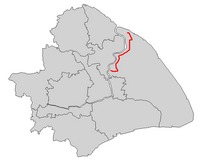Shanghai Metro Line 6
| Line 6, Shanghai Metro | |||
|---|---|---|---|
| 6 | |||

A view of the North Waigaoqiao Free Trade Zone station.
|
|||
| Overview | |||
| Type | Rapid transit / Medium-capacity rail transport system | ||
| Status | In operation | ||
| Locale | Shanghai, China | ||
| Termini |
Gangcheng Road Oriental Sports Center |
||
| Stations | 28 | ||
| Daily ridership | 490,000 (2017 peak) | ||
| Operation | |||
| Opened | December 29, 2007 | ||
| Operator(s) | Shanghai No.4 Metro Operation Co. Ltd. | ||
| Character | Underground and elevated | ||
| Technical | |||
| Line length | 32.318 km (20.08 mi) | ||
| Number of tracks | 2 | ||
| Track gauge | 1,435 mm (4 ft 8 1⁄2 in) | ||
| Electrification | Overhead lines (1500 volts) | ||
| Operating speed | 80 km/h (50 mph) | ||
|
|||
Line 6 is an eastern north-south line of the Shanghai Metro network. The entire line is located in the Pudong New Area. A complete trip between the two end terminals, Gangcheng Road and Oriental Sports Center takes approximately 1 hour and 10 minutes. The line is colored magenta on system maps.
Line 6 opened on December 29, 2007. The trains, with 4 carriages each, are manufactured by Shanghai Electric and Alstom. Like the Lexington Avenue Subway in New York City, passenger traffic has consistently exceeded the designed capacity of the line since its opening and causes severe strain to the services. The line was built to accommodate light metro narrow-bodied "C size" trains, which is not interchangeable with wide-body "A size" trains on other Shanghai Metro lines. This has made it less practical to upgrade the facilities to meet demands.
Line 6 was forecasted to carry 105,000 people/day. However within the first few days of operation the line has exceeded 150,000 people/day. Realizing the sheer miscalculation during construction, the municipal government have pledged to add new trains and shorten wait times starting in June 2008. However, Line 6 still suffers severe crowding and delays especially during rush hours. The busiest section of the line is running at 133% capacity. With the opening of Line 12 the Shanghai Metro advises passengers divert to the new line to relieve crowding.
...
Wikipedia

